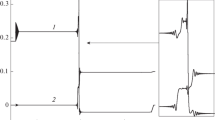Abstract
The properties of ‘discontinuous’ transitions in a current-carrying plasma are analyzed by formulating the problem in terms of the two-fluid (i.e., electrons and ions) equations. The jump conditions, which connect states on either side of a discontinuity, are derived and it is shown that these are similar to the ordinary gas-dynamic Rankine-Hugoniot conditions except that there are extra terms which represent an enhanced mass flux in the momentum equation, and an additional heat, flux in the energy equation, both of which arise from the existence of a current flow through the discontinuity.
the additional heat flux, which is due to collisions between electrons and ions and is carried by the electrons, plays a role analogous to the heat of reaction in the theory of combustion waves and gives rise to Hugoniots (i.e., curves in the pressure-specific volume plane representing the locus of states satisfying conservation of total plasma energy) which may be either ‘exothermic’ or ‘endothermic’ in character. Thus the classification of the various types of discontinuities, permitted by the jump relations, adopted here follows the classical description of detonation and deflagration waves and is based on the nature of the flow (i.e., whether the flow is ‘subsonic’ or ‘supersonic’) ahead of and behind the discontinuity. In an artificial way we show that the effects of reflected particles on such discontinuities can be to alter the nature of the discontinuity. For example in the special case of adiabatic transitions only ‘weak’ transitions are permitted in the absence of reflected particles, whereas in their presence all types (weak and strong) are possible.
The end states permitted by the jump conditions must be joined together by a valid internal structure which can be obtained only by solving the full equations of motion. These are set up and we ask what extra conditions must be fulfilled by a transition characterized by a monotonic change in potential going from zero at one end to a constant value at the other, assuming that the plasma is charge neutral outside the transition region. In the case of adiabatic transitions one extra condition is imposed and this turns out to be a generalization of Block's (1972) self-consistency condition for double layers (which in its turn is an extension of Bohm's condition for the existence of wall sheaths). However the inclusion of dissipative effects indicates that adiabatic transitions are degenerate since the inclusion of dissipation shows that no extra conditions are imposed by requirements stemming from considerations of the self-consistency of the internal structure.
As an example of how such discontinuities may be fitted into flow problems, we examine the construction of discontinuous periodic solutions for streaming ions and electrons. allowing for collisions with a background neutral gas. The idea here is borrowed from the phenomenon of ‘roll waves’, which occur in water flow along an inclined channel including frictional effects, and consist of a series of hydraulic jumps (or ‘bores’) separated by stretches of smooth flow.
Similar content being viewed by others
References
Axford, W. I.: 1961,Phil. Trans. Roy. Soc. 253A, 301.
Biskamp, D.: 1969,J., Plasma Phys. 3, 411.
Block, L. P.: 1972,Cosmic Electrodynamics 3, 349.
Braginskii, S. J.: 1965,Reviews of Plasma Physics, Vol. I, Consultants Bureau, New York.
Carlqvist, P.: 1972,Cosmic Electrodynamics 3, 377.
Courant, R. and Friedrichs, K. O.: 1948,Supersonic Flow and Shock Waves, Interscience Publishers, New York.
Dressler, R. F.: 1949,Comm. Pure Appl. Math. 149.
Goldsworthy, F. A.: 1961,Phil. Trans. Roy. Soc. 253A, 277.
Hayes, W. D.: 1960,Gas Dynamic Discontinuities, Princeton University Press, Princeton, N.J.
Jackson, E. A.: 1960,Phys. Fluids 3, 786.
Jeffreys, H. and Jeffreys, B. S.: 1972,Methods of Mathematical Physics, Cambr. Univ. Press (3rd ed.).
Kahn, F. D.: 1954,Bull. Astron. Inst. Neth. 12, 187.
Knorr, G. and Goertz, C. K.: 1974,Astrophys. Space Sci. 31, 209.
Kontorovich, V. H.: 1957,Akust. Zh. 33, 1527 (1960,Sov. Phys.-Acoustics 5, 320).
Landau., L. D. and Lifshitz, E. M.: 1959,Fluid Mechanics, Pergamon Press., p. 330 and p. 481.
Moiseev, S. S. and Sagdeev, R. Z.: 1963,J. Nuclear Energy, Pt.3, 43.
Montgomery, D. C. and Joyce, G.: 1969,J. Plasma Phys. 3, 1.
Newman, A. C. and Axford, W. I.: 1968,Astrophys. J. 151, 1145.
Persson, H.: 1968,Electron and Plasma Phys., Royal Inst. of Tech. Stockholm., Rep. 68-18.
Persson, H.: 1969,Electron and Plasma Phys. Royal Inst. of Tech. Stockholm, Rep. 69-05.
Stix, T. H.: 1962,Theory of Plasma Waves, McGraw-Hill.
Stoker, J. J.: 1957,Water Waves, The Mathematical Theory and Its Applications, Interscience Publishers Inc., New York, p. 464.
Tidman, D. A. and Krall, N. A.: 1970,Shock Waves in Collisionless Plasmas Wiley-Interscience, New York.
Author information
Authors and Affiliations
Rights and permissions
About this article
Cite this article
Lee, HJ., McKenzie, J.F. & Axford, W.I. Discontinuous transitions in a current-carrying plasma. Astrophys Space Sci 51, 3–32 (1977). https://doi.org/10.1007/BF00642454
Received:
Issue Date:
DOI: https://doi.org/10.1007/BF00642454




